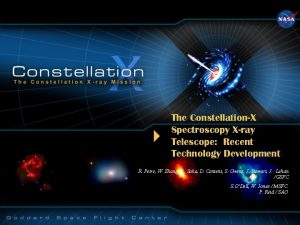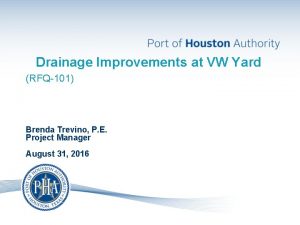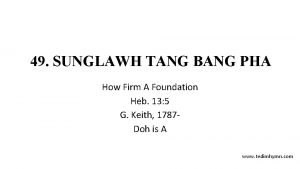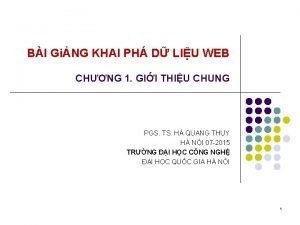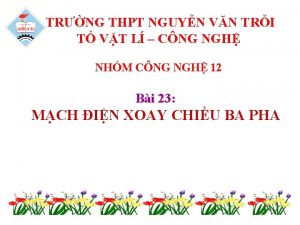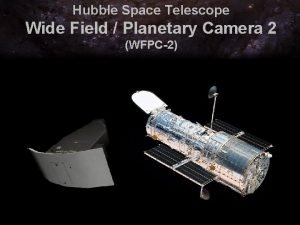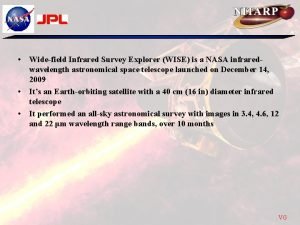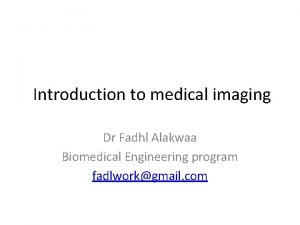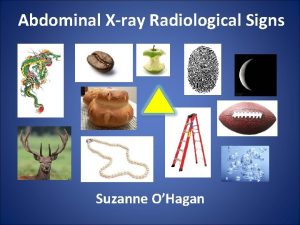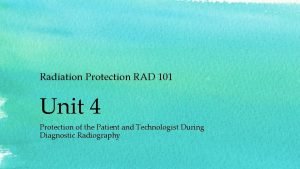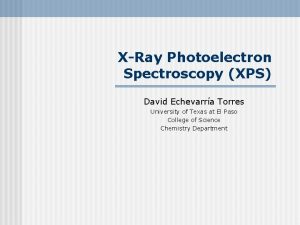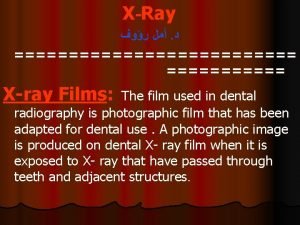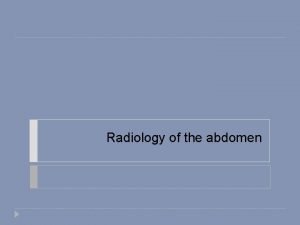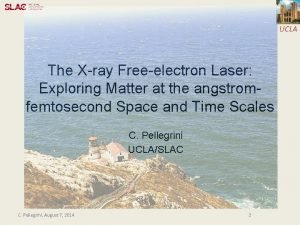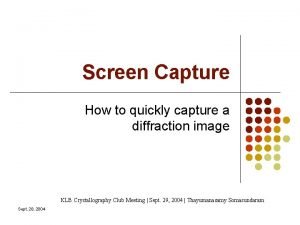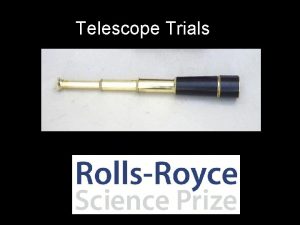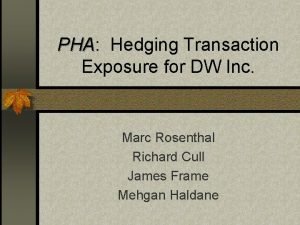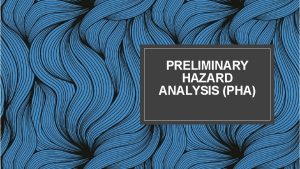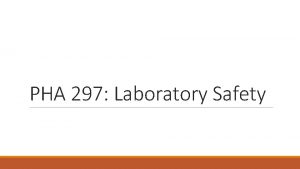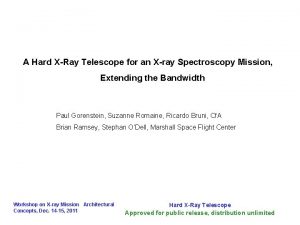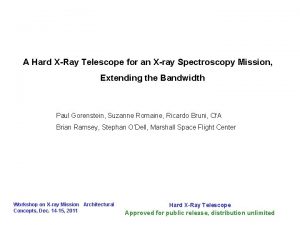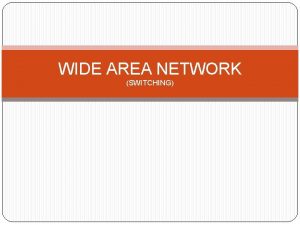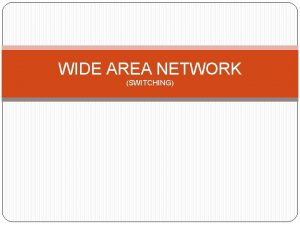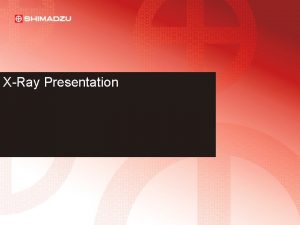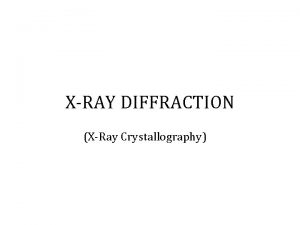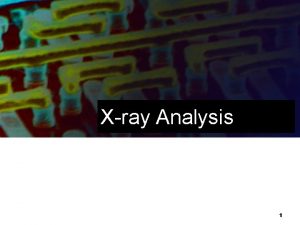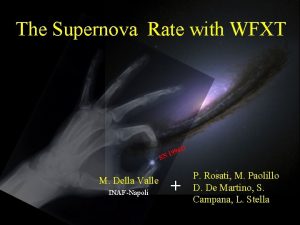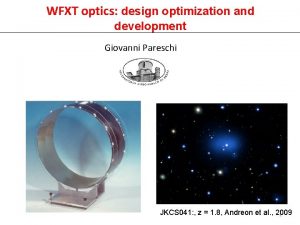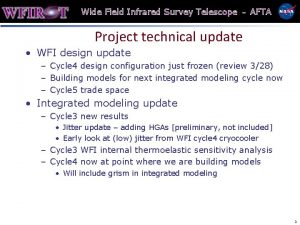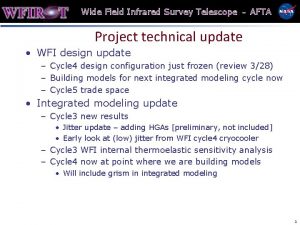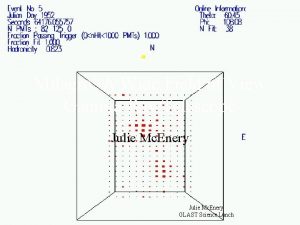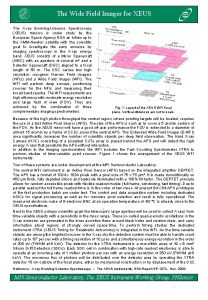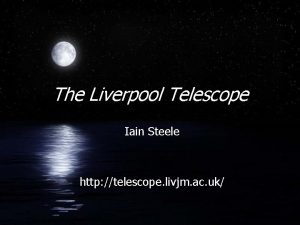Wide Field Xray Telescope http www wfxt pha































- Slides: 31

Wide Field X-ray Telescope http: //www. wfxt. pha. jhu. edu/ http: //www. wfxt. eu/ Stephen Murray for the WFXT Collaboration Johns Hopkins University Dec. 14, 2011 Approved for public release, distribution unlimited

WFXT Collaboration JHU: Stephen S. Murray (PI), Kip Kuntz, Riccardo Giacconi, Timothy Heckman, Suvi Gezari APL: Hal Weaver, Carey Lisse, Neil Miller, Cheryl Reed Cf. A: Alexey Vikhlinin, William Forman, Christine Jones, Andrew Goulding, Paul Reid, Andreas Zezas, Pepi Fabbiano MSFC: Martin Weiskopf, Brian Ramsey, Ron Elsner, Steve ODell GSFC: Andrew Ptak MIT: Mark Bautz Dartmouth: Ryan Hickox PSU: Niel Brandt, Eric Feigleson, Don Schneider Princeton: Neta Bahcall Stanford: Steve Allen MSU: Megan Donahue, Mark Voit U. Michigan: Gus Evrard STSc. I: Kathryn Flanagan, Carol Christian U. Chicago: Andrey Kravtsov U. Waterloo: Brian Mc. Namara ESO: Piero Rosati, Paolo Padovani MPE: Rashid Sunyaev U. Trieste: Stefano Borgani U. Naples: Maurizio Paolillo INAF-Brera: Giovanni Pareschi, Oberto Citterio, Gianpiero Tagliaferri, Sergio Campana, Ginevra Trinchieri, Marta Civitani, Alberto Moretti INAF-Bologna: Roberto Gilli INAF-Trieste: Paolo Tozzi, Joana Santos, Barbara Sartoris INAF-Capodimonte: Massimo Della Valle, Domitilla de Martino ASI Science Data Center: Paolo Giommi Approved for public release, distribution unlimited

The Future of X-ray Surveys First SMBHs, galaxy/AGN co-evolution, feedback mechanisms, cosmic cycle of baryons, structure formation, precision cosmology - all require: High sensitivity Wide survey area Good angular resolution Can be done with a specific X-ray optical design and modest technological 2 development, ready to be done now Approved for public release, distribution unlimited

Beyond e. ROSITA - WFXT • • Three co-aligned 5” HEW, 1 degree Fo. V telescopes, with CCD camera ∼ 10 x Chandra effective area @ 1 ke. V Chandra-like HEO 64 hr period Large field of regard Long observations or Robust multiple telescope/detector system Approved for public release, distribution unlimited Low Earth Orbit 550 km @ 60 Low Background

WFXT “SDSS” for X-rays (Wide), Medium and Deep Surveys XB oo t es Dramatic advance over existing/planned missions in combined solid angle/sensitivity Proven large discovery space Two (three) surveys • (Wide 15, 000 deg 2) • Medium 3000 deg 2 • Deep 100 deg 2, 800 times CDFs GO Program • 40% Observing time Approved for public release, distribution unlimited

WFXT Surveys WFXT Deep Survey = 100 sq deg ~800 times solid angle equivalent of Chandra Deep Fields Description of the WFXT Surveys Survey Quantity Deep Medium Ω (deg 2) 100 3, 000 15, 000 Exposure 400 ksec 13 ksec 2 ksec Total Time 1. 5 yr 2. 0 yr Smin(0. 5 -2 ke. V) point-like erg s-1 cm-2 at 3σ 4. 0 x 10 -17 4. 5 x 10 -16 Deep -15 4. 0 x 10 Total AGN Detected ~4. 7 x 105 ~4. 4 x 106 ~7 x 106 Smin(0. 5 -2 ke. V) extended erg s-1 cm-2 at 5σ 1 x 10 -16 1 x 10 -15 5 x 10 -15 Total Clusters/Groups ~3 x 104 ~2 x 105 Approved for public release, distribution unlimited Wide Medium

Angular resolution HEW= 5” goal over the entire Fo. V • • • Improve sensitivity for point and extended sources, AGN/cluster/group discernment at any redshift Minimize source confusion, especially confusion free Deep survey Efficient identification of optical counterparts, Chandra-like id accuracy (<1” radius error circle, >90% right IDs), essential for 5 x 106 AGN and 2× 105 clusters! Detect sharp features of the ICM (shocks, cold fronts, cavities) Resolve cool cores of z>1 clusters (essential for cosmological applications, reliable mass proxy) HR I PSP C Santos et al. 08 ROSAT Lockman Hole survey (25” vs 5” resolution) (Lehmann et al. 2001) Approved for public release, distribution unlimited

WFXT Telescope Design Key to Wide Field Surveys Vignetting Resolution Area Approved for public release, distribution unlimited

Figure of Merit: Discovery Speed M = (Fo. V) x (Aeff)/(HEW)2 cm 2 Speed in carrying out large sensitive surveys and identifying distinct sources. Cumulative field of view available at a given angular resolution (HEW) as a function of HEW for five missions. Wide field design matters!!! Insert shows the figure of merit for survey discovery speed (Grasp/HEW 2). WFXT is about 100 times better than any past or planned X-ray mission. Approved for public release, distribution unlimited

Simulation: one medium survey “tile” Chandra COSMOS- 1. 8 Msec (1 sq deg) Elvis 2009 WFXT - 20 Ksec Rosati and Tozzi AGN counts (Medium + Deep Surveys) [0. 5 -2] ke. V [2 -4. 5] ke. V ~500, 000 AGN with >400 cts, with full [4. 5 -7] ke. V spectral characterization (obscuration, z, etc. ) WFXT simulation: Same sources as Chandra 5 arc second HEW, not confusion limited ~90 x faster surveys than Chandra Approved for public release, distribution unlimited Bands (ke. V) [0. 5 -1] [1. 0 -2] [2. 0 -7]

High Redshift QSOs L(2 -10 ke. V) = 6 x 1044 erg/s Norman 2002, Comastri 2011 • • Simulated 400 ksec spectrum of highly obscured, high redshift AGN NH =1024, Γ=1. 82, EWline =1 ke. V. 530 counts total Strong iron line and allows an accurate redshift determination from the X-ray data alone. • • • WFXT detects close to 1000 unobscured z>6 QSO’s with more than 400 cts, similar number obscured Pessimistic case assumes an exponential decline towards high-z in the space density of AGN at all luminosities. Synergistic: Euclid and LSST identify the WFXT sources, WFXT picks out the AGN (especially high-z, obscured) Approved for public release, distribution unlimited

Synergies with other wide area surveys WFXT is the only X-ray mission that will match, in area and sensitivity, the next generation of wide-area O/IR and radio surveys z=6 Medium Survey QSO N 6240 @z=6 QSO mean SED z=6 Deep Survey QSO Approved for public release, distribution unlimited Courtesy of R. Gillli

How will we identify 500, 000 clusters and 100 million AGN ? ? ? Source identification (optical) LSST 10 yr (ugrizy) LSST ~1 wk Pan STARRS (gvrizy) 20, 000 Wide 3000 Medium 100 Deep SDSS (gvriz) CDFS 2 Msec IDs (Luo et al. 2008) Approved for public release, distribution unlimited

Source identification (near IR) Euclid DS 50 deg 2 Euclid, 20000 deg 2 VISTA/Viking, 20000 deg 2 20, 000 Wide 3000 Medium 100 Deep VISTA/VHS, 20000 deg 2 Approved for public release, distribution unlimited Courtesy of C. Vignal

AGN Clustering Correlation function <=> halo mass WFXT X-RAY SURVEYS can answer. . . 1. Do “typical” (ie. X-ray selected) AGN represent just a slow, stochastic decay from the QSO phase? If so, expect some dependence of bias with luminosity, but (possibly) relatively weak merger signal compared to quasars (e. g. Hopkins et al. ) 2. OR do X-ray AGN have their own triggers, e. g. secular accretion of cold gas (e. g. disk instabilities), through cooling from halo, minor interactions etc. . If so, might expect weak dependence of bias with luminosity, but might expect small-scale signal if fueled by interactions Approved for public release, distribution unlimited

AGN Clustering correlation function → Correlation function <=> halo mass & interactions Clustering on large scales tells us HALO MASS: How is the growth of black holes related to the growth of large-scale structure? Approved for public release, distribution unlimited log (halo mass) → separation → Radio X-ray clear trends, but still large uncertainties IRAC redshift →

AGN Clustering Correlation function <=> halo mass & interactions ? Clustering on small scales tells us MERGERS AND INTERACTIONS Theoretical make different predictions for AGN clustering but differences can be small log (halo mass) → correlation function → small scales poorly understood for AGN Radio X-ray IRAC we need much better statistics: WFXT Approved for public release, distribution unlimited redshift →

z=1. 6 WFXT simulation: 20 ksec z=2. 0 Cluster counts (Medium + Deep Surveys) >3, 000 clusters at z>0. 5, from which z can be be measured from Fe line 13 13 Approved for public release, distribution unlimited

Not just a cluster counting machine Cluster Surveys • Characterize ICM properties and measure mass proxies for thousands of clusters at z>1. • Trace the epoch of entropy injection and metal enrichment of the ICM. • Study the intense dynamics of proto-cluster assembly at z~2. • Multi-λ synergies: a vast scientific legacy for decades to come • Path finder follow-up studies with ELTs, ALMA, SMART-X, . . . Detected clusters: ~200, 000 total z>0. 5: ~125, 000 z>1: ~50, 000 Directly measured z and k. T: >~5000 total z>1: ~2, 000 T profiles and abundances z>0. 5: ~500 ROSAT WFXT z>1 XMM, Spitzer @ z>1 • WFXT forecast based evolution of the cluster abundance and the space distribution of 5000 clusters • Redshifts and mass proxies are derived from the WFXT alone • w 0 and ΩDE are measured with 6% and 1% accuracy (68% c. l. ), when a flat Universe is assumed. Approved for public release, distribution unlimited

Mission Implementation • Three modules approximately co-aligned • Telescope, detector, aspect system, bench • Photon-counting, post-facto image reconstruction • Chandra/Suzaku CCDs available Area • 55 fused silica shells/module • 2 -3 mm thick, 0. 36 -1. 10 m diameter • 0. 220 -0. 408 m long • 300 kg/module (with structure) Approved for public release, distribution unlimited

Mission Implementation • Three modules approximately co-aligned • Telescope, detector, aspect system, bench • Photon-counting, post-facto image reconstruction • Chandra/Suzaku CCDs available • Mirror development well underway: 10” HEW already achieved Citterio 1999 Approved for public release, distribution unlimited

Wide Field Telescope Design Item Value Number of Shells Focal Length Diameter Length Thickness Mass Area Comment 55 Nested fused silica 5. 5 m 0. 36 -1. 10 m 0. 220 - 0. 408 m inner shells shorter 1. 7 -3. 0 mm inner shells thinner 300 kg includes structure 2, 250 cm 2 @ 1 ke. V Area Approved for public release, distribution unlimited

Telescope Process Manufacturing Process Prototype Shell X-ray Test at Panter - Dec 12, 2011 Approved for public release, distribution unlimited

X-ray Testing at MPE Panter Prototype in Panter Chamber Ring Focus (200 mm out of focus) Round shell shows that the support mount works On-axis @ 0. 28 ke. V Metrology predicts X-ray performance

Spacecraft and Launch Payload fits within the standard Atlas V fairing and is also compatible with Falcon 9 • System requirements are all well within current capabilities. • WFXT is an order of magnitude less demanding than Chandra for attitude control and knowledge. • Margins on mass (~30%) and power (~80%) are large Item Mass (kg) Power (W) includes contingency S/C Bus - dry 1010 453 Science Payload 1638 663 Flight System - dry 2648 1116 Propellant 49 Flight System - launch 2697 1116 Capacity 3500 2000 Margin 30% Approved for public release, distribution unlimited 79%

Mass and Power WFXT design is mature and includes large contingency. With an assumed Atlas V launch the margins are quite large A less expensive, but more capable Falcon 9 would provide even larger margin Approved for public release, distribution unlimited

Cost and Schedule Cost validated by a model based independent cost estimate at 70% confidence Mission schedule: 66 months to launch 60 month operations Approved for public release, distribution unlimited

WFXT: The Ultimate X-Ray Survey • • • WFXT addresses New World New Horizons science objectives • • What happens close to a black hole (seconds to days) ? Growth and evolution of supermassive black holes (z>6) Formation/evolution of clusters of galaxies and cosmology (z>1. 5) Growth of Large Scale Structure and the Cosmic Web WFXT is technically ready to start and launch in 5. 5 years • • Large mass and power margins above standard contingencies TRL >= 6, except for telescope currently at TRL=4, development already in place to achieve TRL 6 by the end of Phase A WFXT is a moderate class mission • • Cost < $1 B (US FY 12) including 30% reserves, launch, operations and a funded GO program Validated by independent cost estimate $779 M + launch ($90 -180 M) Approved for public release, distribution unlimited

CST Questions • Can WFXT address “What happens close to a black hole” using Fe-L line measurements? • Besides stacking analyses, WFXT will have the power to perform X-ray reverberation mapping for single AGN using the Fe-L line as done by XMM for 1 H 0707 -495 (Fabian et al. 2009, Zoghbi et al. 2011). The XMM measurements just required CCD resolution and photon statistics of a few hundred thousands photons, well within reach of WFXT for bright sources. As an example, a 100 ks WFXT observation of 1 H 0707 -495 would produce>1 x 107 counts and excellent mapping of the Fe-L line at ~0. 9 ke. V rest frame.

• For how many AGN in the survey will WFXT be able to directly measure masses and spins from the X-ray spectrum? • • Detection of Fe-L line in AGN is relatively rare, while Fe-K line at ~6. 4 ke. V appears to be a more common feature. The Fe-K line will fall within the WFXT goal bandpass at z> 0. 1. By requiring a photon statistics of 1 x 106 photons to measure the line profile and line-continuum time delays (as typical of such studies with Chandra and XMM), one would expect to measure both BH spin and mass for a few (~5) AGN in the WFXT deep survey. However, the WFXT surveys will tend to avoid regions with bright sources. Instead, if 10 Ms (i. e. about half-year at 0. 7 efficiency) are dedicated to observations of bright AGN in the GO phase, this will allow measurement of spin and BH mass for up to ~100 unobscured AGN with more than 1 x 106 net counts each, (i. e. 100 unobscured AGN with fsoft > 4 x 10 -12 erg/cm 2/s observed for 100 ks each). Note: the exact number depends on the distribution of BH masses - hence of spectral time lags. As far as variability to sample what happens close to the central BH, lags between different energy bands have been observed by XMM (Fabian et al 2009, Zoghbi et al 2010, 2011, Miller et al. 2010), so WFXT will do better in terms of photon statistics sampling more AGNs (the timescales are hundreds to thousand of seconds). Measurements of lags in the X-ray spectra themselves are limited today to only a few objects (3 -5), and WFXT will allow access to tens to hundreds of AGNs with similar statistics, but the precise number depend on the time spent in long observing campaigns on each target (>200 ks each). Looking at variability lags between narrow X -ray bands, in principle, probes the structure of the accretion disk. If detected they may constrain the size and geometry of the "hotspots". However, since WFXT is not efficient in hard X-rays, the improvement space wrt XMM is limited, as the reflected component needs to be a significant part of the spectrum to do such studies (and only for very nearby AGNs, so redshift won't help).

• How will the 1200 -9000 z>6 AGN be identified? By WFXT itself from Fe K lines, or in followup surveys? If the space density of z>6 AGN is uncertain by a factor of >20, how can the expected number of AGN be limited to a range of < 10 x? • • How many clusters, at which redshifts, will WFXT be able to measure as mass proxies? • • The Fe-K line will be used, as we applied a 400 ct threshold for determining the number of AGN. We wrote that we expect "about 1200 -9000 objects" at z>6, and later on we wrote that "the space density of such z>6 AGNs is uncertain by at least a factor of 20". This is because the discrepancy between model expectations increases towards lowluminosities/faint-fluxes. When computing the total number of objects expected by WFXT according to different models, we are also (obviously) counting AGN at highluminosities/high-fluxes, where we know how things go. Therefore, the uncertainty on the total number of objects at z>6 has to include all luminosities/fluxes, and is therefore smaller than the uncertainty on low-luminosity/low-flux AGN. We expect to detect ~5000 clusters at z>0, 5 for which we can determine from the X-ray data alone the temperature and redshift with enough accuracy to be useful as mass proxies, and for cosmology. of these , about 3000 will be in the 0. 5 - 1. 0 redshift range, and 2000 will be at z>1. 0. This sample is ~50 times the present ROSAT survey cluster sample - for which Chandra and/or XMM follow up was used to get the high quality X-ray data needed. Regarding cluster cosmology, what will be the advance of WFXT over e. ROSITA, especially in regards to the DE measurements (e. g. Figure 5)? • See the predictions from e. ROSITA, but see the presenttions from the e. ROSITA 2011 Conference: H. Boehringer: "Prospects for e. ROSITA Galaxy Cluster Research" A. Pillepich: "The X-ray cluster survey with e. ROSITA: predictions for cosmology, cluster
 Xray telescope
Xray telescope Extreme wide shot (ews) adalah
Extreme wide shot (ews) adalah Vw pha
Vw pha Thiết kế nghiên cứu khám phá
Thiết kế nghiên cứu khám phá Rubisco enzim
Rubisco enzim Cách pha chế dung dịch canxi hiđroxit
Cách pha chế dung dịch canxi hiđroxit Heb pha
Heb pha Pha associates
Pha associates Quy trình khai phá dữ liệu
Quy trình khai phá dữ liệu Cách nối nguồn điện 3 pha
Cách nối nguồn điện 3 pha Lược đồ quang trung đại phá quân thanh
Lược đồ quang trung đại phá quân thanh Vua nào đại phá quân thanh tơi bời
Vua nào đại phá quân thanh tơi bời Wide field and planetary camera 2
Wide field and planetary camera 2 Wide field infrared survey explorer
Wide field infrared survey explorer Field dependent vs field independent
Field dependent vs field independent Field dependent and field independent
Field dependent and field independent Q factor of capacitor
Q factor of capacitor Magnetic field
Magnetic field E field h field
E field h field Field dependent vs field independent
Field dependent vs field independent 21lwuy8i6hw -site:youtube.com
21lwuy8i6hw -site:youtube.com Data types and field properties
Data types and field properties Fadhl alakwaa
Fadhl alakwaa Signo rigler
Signo rigler Xray technique chart
Xray technique chart Xps instrument
Xps instrument Dental xray films
Dental xray films Rigler sign
Rigler sign Xray laser
Xray laser Prehistoric era
Prehistoric era Unipolar generator
Unipolar generator Gimp xray
Gimp xray
